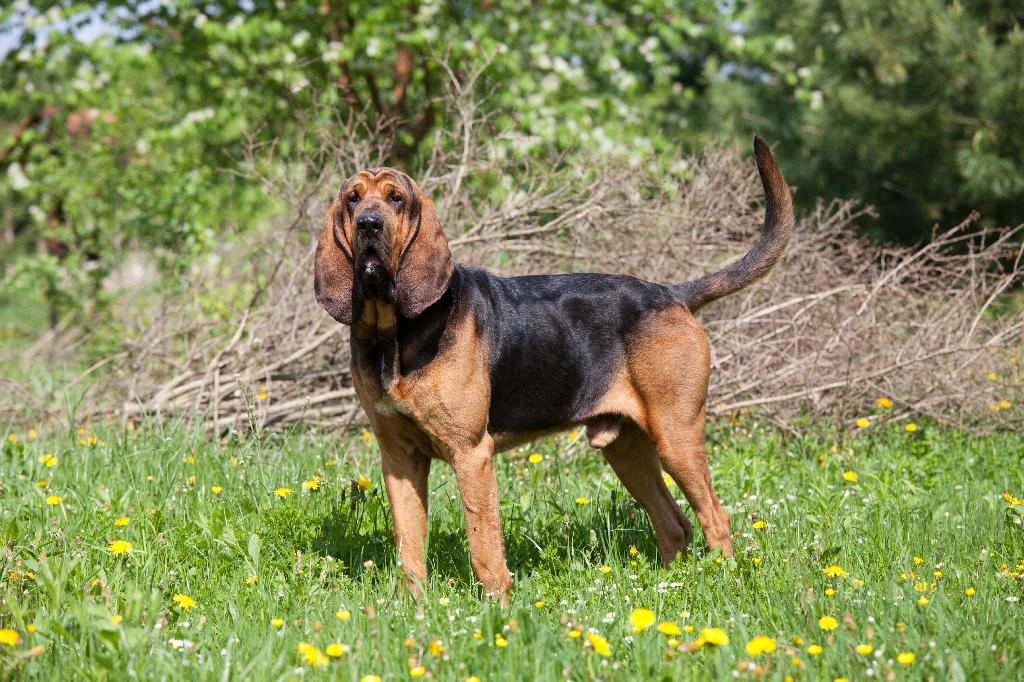Bloodhound

Description
The Bloodhound is a large, distinctive breed of dog renowned for its exceptional scenting ability and its history as a tracking hound. Originally bred in Belgium and refined in England, the Bloodhound is primarily known for its unmatched ability to track scents over long distances, making it a valuable dog for search-and-rescue operations, law enforcement, and tracking fugitives.
Physically, the Bloodhound has a noble and powerful build, with a long, wrinkled face, drooping ears, and a distinctively wrinkled neck. It has a short, dense coat that can be black and tan, liver and tan, or red. The breed's most notable features are its long ears, expressive eyes, and droopy skin, which contribute to its unique appearance. Its large frame and long legs give it the endurance needed for tracking.
Temperament-wise, Bloodhounds are known for being affectionate, gentle, and good-natured dogs. They are typically friendly with children, other pets, and strangers, though they can be independent and stubborn, especially when it comes to following a scent. Due to their strong hunting instincts, they require early socialization to ensure they interact well with other animals and people. Bloodhounds are highly intelligent but can be difficult to train because of their independent nature and strong drive to follow scents. Positive reinforcement and patience are key when training this breed.
The Bloodhound is an energetic dog that requires regular exercise and mental stimulation to remain happy and healthy. Its keen sense of smell, which is among the best in the canine world, means it needs to be kept on a leash or in a securely fenced area, as it can easily become distracted by scents and may wander off in pursuit of a trail.
Overall, the Bloodhound is a remarkable working dog with incredible tracking skills, making it an invaluable asset in search-and-rescue and law enforcement. With the right training, socialization, and care, it can also be a loyal, affectionate companion, though it is best suited for experienced dog owners who can manage its strong instincts and need for exercise.
History
The Bloodhound is an ancient breed with roots stretching back at least a millennium. Its direct ancestors are often linked to the hounds bred by monks in the Ardennes region of what is now Belgium, particularly those associated with the monastery of Saint-Hubert. By the early Middle Ages, dogs of this type were prized for their unmatched scenting ability and used extensively by nobility and the clergy alike. Over time, these Saint Hubert hounds spread across Europe, evolving into various regional scenthound strains. The name “Bloodhound” emerged later and is sometimes interpreted to mean “hound of pure or noble blood,” reflecting the breed’s carefully maintained lineage.
During the medieval and Renaissance periods, Bloodhounds gained a reputation for being especially adept at tracking humans—whether it was poachers, outlaws, or missing persons. English and French nobility in particular relied on the breed for specialized hunts and law enforcement. By the 16th and 17th centuries, references in literature and legal documents attest to the Bloodhound’s remarkable tracking prowess. Stories of their ability to follow trails that were days old added to the breed’s almost legendary status. As the Bloodhound was introduced to more countries, including those in the New World, its role as a specialized tracker and law enforcement tool expanded further.
In modern times, the Bloodhound’s utility has spanned search and rescue, forensic tracking, and police K-9 units. Their extraordinary nose—scientifically recognized as one of the most sensitive among domestic dogs—has led to evidence gathered by Bloodhounds being admissible in some courts of law. The breed’s formal recognition by kennel clubs such as the American Kennel Club (AKC) came in the late 19th century, helping to standardize Bloodhound conformation and temperament. Today, while still esteemed in working circles, the Bloodhound also appears in family homes, known for its calm and gentle demeanor. However, the breed’s long history of meticulous selection for scent tracking remains its defining hallmark, continuing a lineage that traces back to medieval monasteries and noble hunting grounds.
Colors
• Black and Tan
• Liver & Tan
• Red


